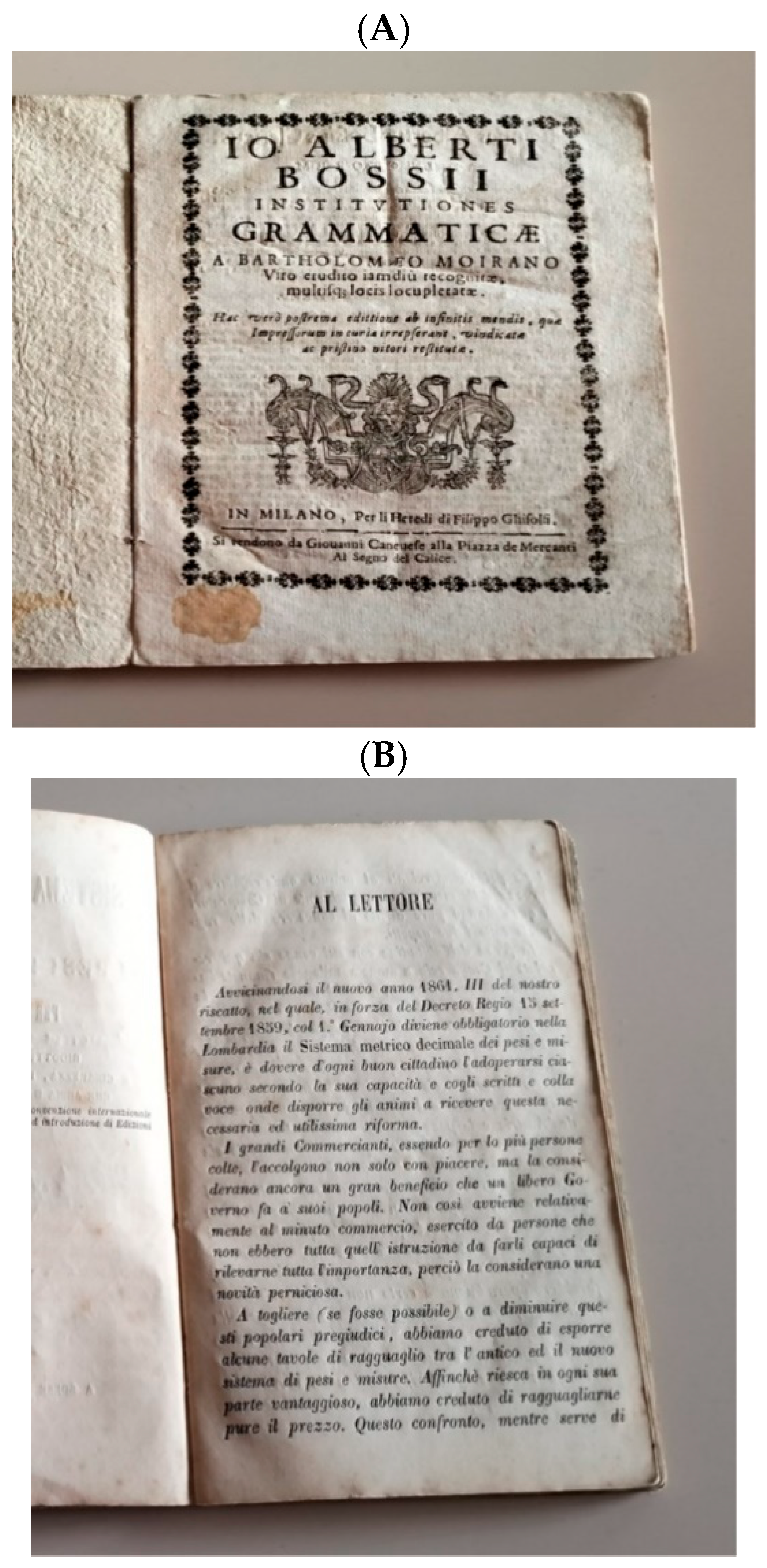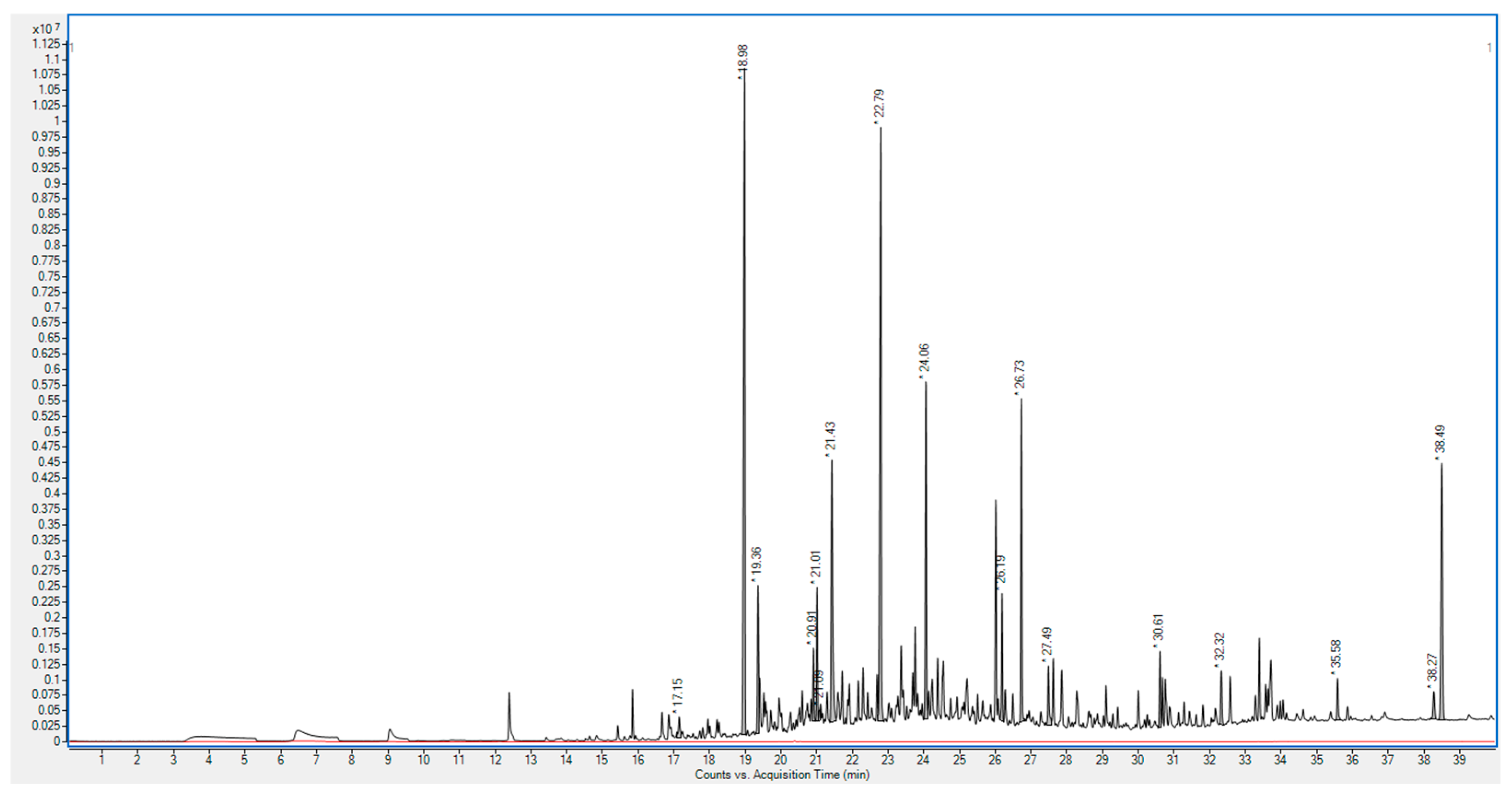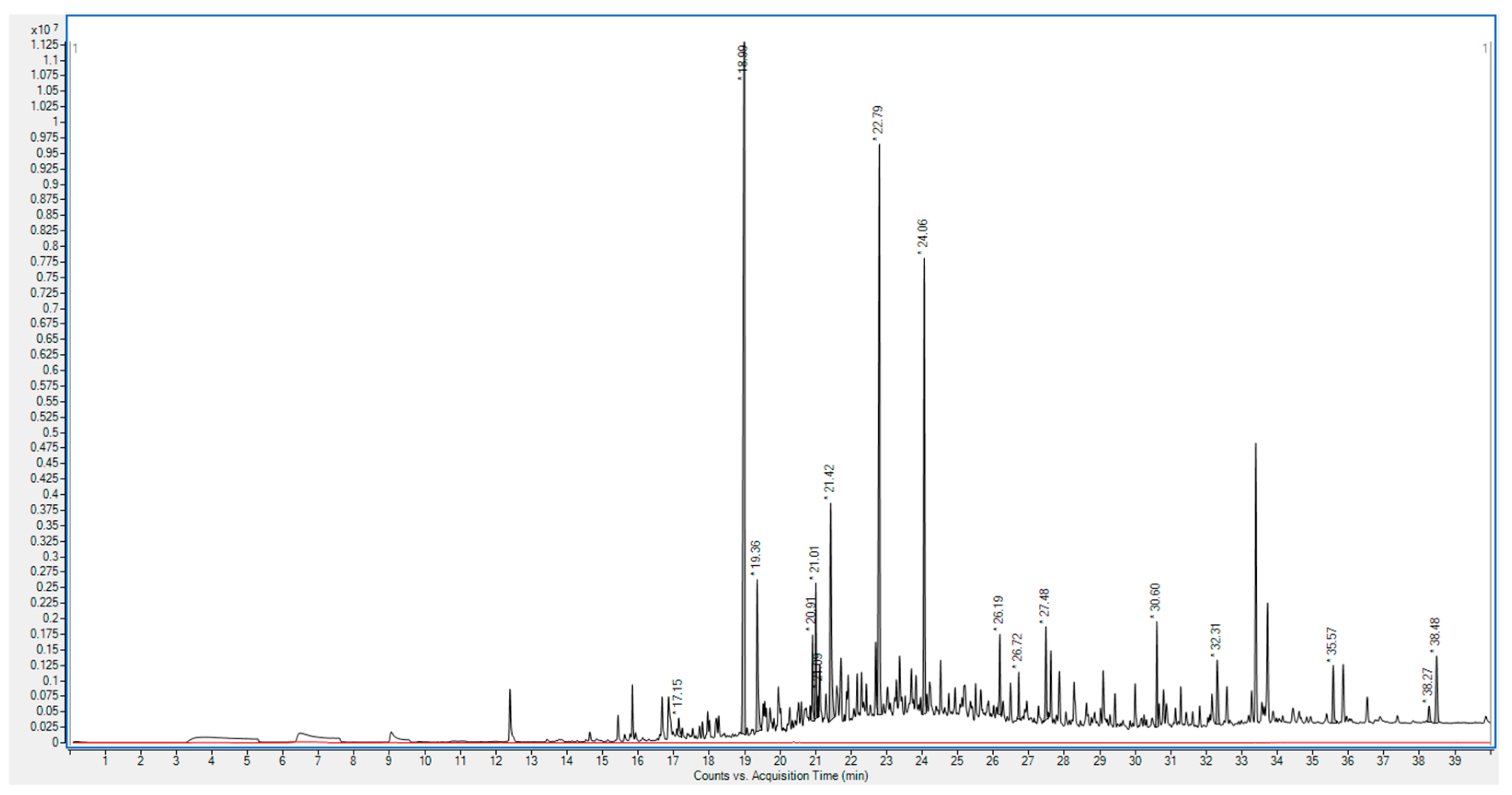Modern Analytical Chemistry Meets Heritage Books: Analysis of Volatile Organic Compounds (VOCs) from Two Books Preserved at the Biblioteca Capitolare of Busto Arsizio
Abstract
1. Introduction
2. Results
2.1. VOC Profile of the 16th-Century Book
2.2. VOC Profile of the 19th-Century Book
2.3. Comparative Analysis of VOC Profiles and Implications for Conservation
3. Discussion
4. Materials and Methods
4.1. Sample Collection and Storage
4.2. Headspace Solid-Phase Microextraction
4.3. Gas Chromatography–Mass Spectrometry Analysis
4.4. Semiquantitative Analysis of VOCs
4.5. Quality Control and Blank Runs
Author Contributions
Funding
Institutional Review Board Statement
Informed Consent Statement
Data Availability Statement
Conflicts of Interest
Appendix A
References
- Yan, Y.; Tang, Y.; Yang, Y. Chemical Conservation of Paper-Based Cultural Heritage. Molecules 2024, 30, 122. [Google Scholar] [CrossRef] [PubMed]
- Botti, S.; Bonfigli, F.; Mezi, L.; Flora, F. Monitoring of Cleaning Treatments for Paper Heritage with Raman Spectroscopy Mapping. Molecules 2023, 29, 15. [Google Scholar] [CrossRef] [PubMed]
- Botti, S.; Bonfigli, F.; Nigro, V.; Rufoloni, A.; Vannozzi, A. Evaluating the Conservation State of Naturally Aged Paper with Raman and Luminescence Spectral Mapping: Toward a Non-Destructive Diagnostic Protocol. Molecules 2022, 27, 1712. [Google Scholar] [CrossRef] [PubMed]
- Nemoykina, A.L.; Shabalina, A.V.; Svetlichnyi, V.A. Restoration and conservation of old low-quality book paper using aqueous colloids of magnesium oxyhydroxide obtained by pulsed laser ablation. J. Cult. Herit. 2019, 39, 42–48. [Google Scholar] [CrossRef]
- Croitoru, C.; Roata, I.C. Ionic Liquids as Reconditioning Agents for Paper Artifacts. Molecules 2024, 29, 963. [Google Scholar] [CrossRef] [PubMed]
- Sequeira, S.O.; Pasnak, E.; Viegas, C.; Gomes, B.; Dias, M.; Cervantes, R.; Pena, P.; Twarużek, M.; Kosicki, R.; Viegas, S.; et al. Microbial assessment in a rare Norwegian book collection: A One Health approach to cultural heritage. Microorganisms 2024, 12, 1215. [Google Scholar] [CrossRef] [PubMed]
- Zhang, M.; Zhao, J.; Wang, S.; Dai, Z.; Qin, S.; Mei, S.; Zhang, W.; Guo, R. Carbon quantum dots for long-term protection against UV degradation and acidification in paper-based relics. ACS Appl. Mater. Interfaces 2024, 16, 5009–5018. [Google Scholar] [CrossRef] [PubMed]
- Gaspar, E.M.; Santana, J.C.; Lopes, J.F.; Diniz, M.B. Volatile organic compounds in paper—An approach for identification of markers in aged books. Anal. Bioanal. Chem. 2010, 397, 369–380. [Google Scholar] [CrossRef] [PubMed]
- Verticchio, E.; Frasca, F.; Cavalieri, P.; Teodonio, L.; Fugaro, D.; Siani, A.M. Conservation risks for paper collections induced by the microclimate in the repository of the Alessandrina Library in Rome (Italy). Herit. Sci. 2022, 10, 80. [Google Scholar] [CrossRef] [PubMed]
- Clark, A.J.; Calvillo, J.L.; Roosa, M.S.; Green, D.B.; Ganske, J.A. Degradation product emission from historic and modern books by headspace SPME/GC-MS: Evaluation of lipid oxidation and cellulose hydrolysis. Anal. Bioanal. Chem. 2011, 399, 3589–3600. [Google Scholar] [CrossRef] [PubMed]
- Stylianou, M.; Barlet, C.; Andreou, C.; Agapiou, A. Assessment of volatile emissions by aging books. Environ. Sci. Pollut. Res. 2024, 31, 17670–17677. [Google Scholar] [CrossRef] [PubMed]
- Battistel, D.; Padovani, I.; Dallo, F.; Barbante, C.; Zendri, E.; Balliana, E. Evaluation of the volatile organic compound emissions in modern and naturally aged Japanese paper. J. Cult. Herit. 2018, 33, 18–29. [Google Scholar] [CrossRef]
- Łojewski, T.; Sawoszczuk, T.; Łagan, J.M.; Zięba, K.; Barański, A.; Łojewska, J. Furfural as a marker of cellulose degradation: A quantitative approach. Appl. Phys. A 2010, 100, 873–884. [Google Scholar] [CrossRef]
- Ludwiczuk, A.; Kieltyka-Dadasiewicz, A.; Sawicki, R.; Golus, D.; Ginalska, G. Essential oils of some Mentha species and cultivars, their chemistry and bacteriostatic activity. Nat. Prod. Commun. 2016, 11, 1015–1018. [Google Scholar] [CrossRef] [PubMed]
- Galgano, M.; Capozza, P.; Pellegrini, F.; Cordisco, M.; Sposato, A.; Sblano, S.; Camero, M.; Lanave, G.; Fracchiolla, G.; Corrente, M.; et al. Antimicrobial activity of essential oils evaluated in vitro against Escherichia coli and Staphylococcus aureus. Antibiotics 2022, 11, 979. [Google Scholar] [CrossRef] [PubMed]
- Lattuati-Derieux, A.; Bonnassies-Termes, S.; Lavédrine, B. Identification of volatile organic compounds emitted by a naturally aged book using solid-phase microextraction/gas chromatography/mass spectrometry. J. Chromatogr. A 2004, 1026, 9–18. [Google Scholar] [CrossRef] [PubMed]
- Lattuati-Derieux, A.; Bonnassies-Termes, S.; Lavédrine, B. Characterisation of compounds emitted during natural and artificial ageing of a book: Use of headspace-solid-phase microextraction/gas chromatography/mass spectrometry. J. Cult. Herit. 2006, 7, 123–133. [Google Scholar] [CrossRef]



| Retention Time (min) | SI (NIST-20) | LRI (Calculated) | LRI (Theoretical) | Area % | ||
|---|---|---|---|---|---|---|
| Compound | XVI Century Book | XIX Century Book | ||||
| Octanal | 17.15 | 771 | 1304 | 1289 (±9) | 0.42 | 0.46 |
| Tetradecane | 18.98 | 909 | 1401 | 1400 | 12.48 | 17.81 |
| Nonanal | 19.36 | 879 | 1424 | 1391 (±8) | 2.36 | 2.25 |
| Pentadecane | 20.91 | 786 | 1502 | 1500 | 0.97 | 1.05 |
| 2-ethylhexanol | 21.01 | 844 | 1506 | 1491 (±5) | 1.61 | 1.57 |
| Furfural | 21.09 | 830 | 1511 | 1461 (±11) | 0.11 | 0.31 * |
| Decanal | 21.42 | 879 | 1538 | 1498 (±8) | 4.76 | 3.90 |
| Hexadecane | 22.79 | 913 | 1601 | 1600 | 10.45 | 10.06 |
| Menthol | 24.05 | 911 | 1673 | 1637 (±6) | 4.67 | 6.30 |
| Octadecane | 26.19 | 825 | 1802 | 1800 | 1.66 | 1.38 |
| Butoxyethoxy ethanol | 26.73 | 894 | 1827 | 1796 (±13) | 4.35 | 0.71 |
| Anethole | 27.49 | 698 | 1845 | 1817 (±5) | 1.05 | 1.43 |
| Diphenyl ether | 30.61 | 809 | 2129 | 2017 (±15) | 1.01 | 1.42 |
| Diisopropylnaphthalene | 32.32 | 719 | 2230 | 2228 (±14) | 4.65 | 5.06 |
| Diethyl phthalate | 35.58 | 745 | 2394 | 2365 (±7) | 0.77 | 1.05 |
| Benzophenone | 38.27 | 678 | 2508 | 2450 (±16) | 0.59 | 0.36 |
| Diisobutyl phthalate | 38.49 | 916 | 2525 | 2536 (±10) | 5.76 | 1.45 |
| Total aldehyde | 7.54 * | 6.61 | ||||
| Total hydrocarbons | 25.56 | 30.30 * | ||||
Disclaimer/Publisher’s Note: The statements, opinions and data contained in all publications are solely those of the individual author(s) and contributor(s) and not of MDPI and/or the editor(s). MDPI and/or the editor(s) disclaim responsibility for any injury to people or property resulting from any ideas, methods, instructions or products referred to in the content. |
© 2025 by the authors. Licensee MDPI, Basel, Switzerland. This article is an open access article distributed under the terms and conditions of the Creative Commons Attribution (CC BY) license (https://creativecommons.org/licenses/by/4.0/).
Share and Cite
Chiodini, C.; Rovellini, P.; Chiodini, M.; Giacomelli, L.; Baglio, D.; the 5B IISS Torno Working Group. Modern Analytical Chemistry Meets Heritage Books: Analysis of Volatile Organic Compounds (VOCs) from Two Books Preserved at the Biblioteca Capitolare of Busto Arsizio. Molecules 2025, 30, 2447. https://doi.org/10.3390/molecules30112447
Chiodini C, Rovellini P, Chiodini M, Giacomelli L, Baglio D, the 5B IISS Torno Working Group. Modern Analytical Chemistry Meets Heritage Books: Analysis of Volatile Organic Compounds (VOCs) from Two Books Preserved at the Biblioteca Capitolare of Busto Arsizio. Molecules. 2025; 30(11):2447. https://doi.org/10.3390/molecules30112447
Chicago/Turabian StyleChiodini, Chiara, Pierangela Rovellini, Matteo Chiodini, Luca Giacomelli, Daniela Baglio, and the 5B IISS Torno Working Group. 2025. "Modern Analytical Chemistry Meets Heritage Books: Analysis of Volatile Organic Compounds (VOCs) from Two Books Preserved at the Biblioteca Capitolare of Busto Arsizio" Molecules 30, no. 11: 2447. https://doi.org/10.3390/molecules30112447
APA StyleChiodini, C., Rovellini, P., Chiodini, M., Giacomelli, L., Baglio, D., & the 5B IISS Torno Working Group. (2025). Modern Analytical Chemistry Meets Heritage Books: Analysis of Volatile Organic Compounds (VOCs) from Two Books Preserved at the Biblioteca Capitolare of Busto Arsizio. Molecules, 30(11), 2447. https://doi.org/10.3390/molecules30112447









